Smooth and clean facial skin indicates not only that a woman takes good care of herself, but also that she is healthy. At a certain period of life, the appearance of acne on the face is natural, since the condition of the skin is influenced by hormonal processes occurring in the body. Sharp hormonal changes occur, for example, during adolescence. Pharmacy medications and folk remedies will help get rid of acne or reddish rashes and prevent acne from appearing on the cheeks. Eliminating the causes of their formation will make the skin healthy, restore good mood and attractiveness.
Content:
- How do acne form?
- Causes of acne on the face
- What health problems does the location of pimples indicate?
- The appearance of rashes on the cheeks due to hormonal imbalance
- Pimples on the cheeks due to intestinal dysbiosis
- Pimples on the cheeks with demodicosis
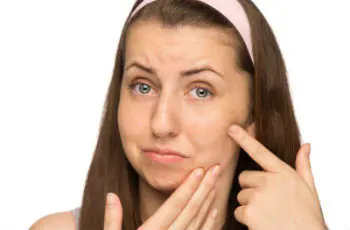
How do acne form?
Human skin is covered with small hairs. Acne appears as a result of an inflammatory process in the area of the hair follicle (follicle) and the sebaceous glands located here. When sebum is mixed with sweat, bacteria begin to actively multiply, and from the surface of the skin through the pores they enter into its depths.
In this case, subcutaneous seals of a reddish color are formed, protruding above its surface (papules) or purulent capsules (pustules). If the pores become clogged with a mixture of sebum and dying epithelial particles, comedones are formed - white subcutaneous pimples or blackheads.
The appearance of acne upsets any person. Red, black or purulent rashes on the face not only make it unattractive, but are also accompanied by itching and can be painful. Acne appears especially often on the cheeks of women with oily skin. Increased activity of the sebaceous glands leads to the formation of a large amount of sebum, released through enlarged pores.
Warning: Trying to get rid of acne, they begin to squeeze them out, which not only leads to the opposite result, but most often makes the situation even worse. The infection spreads deep into the skin, abscesses (boils) form, and individual areas of inflammation merge.
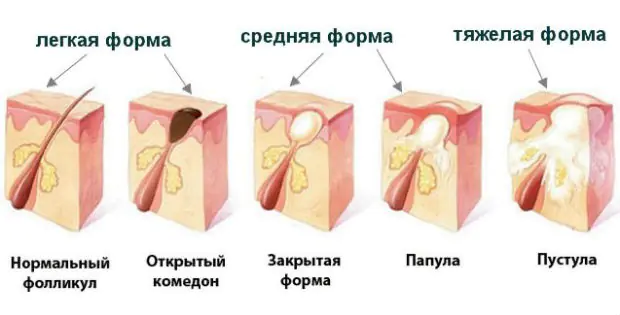
Causes of acne on the face
Pimples on the cheeks can be a hereditary problem associated with the functioning of the sebaceous glands and the occurrence of various biological processes in the body. In this case, it is necessary to put in a lot of effort to make the skin defect less noticeable.
But in most cases, the cause of acne is:
- poor diet, constant consumption of fatty and spicy foods that stimulate the sebaceous glands;
- food poisoning of the body, the entry of toxins into it from air or water contaminated with industrial toxic substances;
- weakened immunity and general physical condition, emotional stress;
- effects on the body of nicotine, alcohol, drugs;
- physiological or pathological changes in hormonal levels;
- the presence of diseases of internal organs and the nervous system, often acne on the cheeks is one of the symptoms of such pathologies;
- metabolic disorders resulting from diseases of the liver, digestive and urinary systems;
- allergic reaction to certain foods, medications, cosmetics;
- infection with parasites (hypodermic demodex mite, worms, Giardia).
Insufficient or improper facial skin care, including the use of cosmetics without taking into account skin type, is the most common cause of acne, as is rubbing the face with a rough towel or washing with a washcloth. Cold water does not wash away dirt and sebum well, and constant washing with hot water leads to enlarged pores and increased sebum production. Therefore, cosmetologists recommend washing your face with slightly warm water.
What health problems does the location of pimples indicate?
Often, the localization of pimples in certain areas of the face is associated with certain pathologies. Thus, the cause of rashes on the cheekbones is often the presence of kidney disease. Small pimples often appear around the mouth due to inflammation of the tonsils and pharynx.
Extensive rashes in the face and neck appear due to intoxication of the body. The formation of pimples on the nose indicates that there are abnormalities in the functioning of the intestines, stomach, and pancreas.
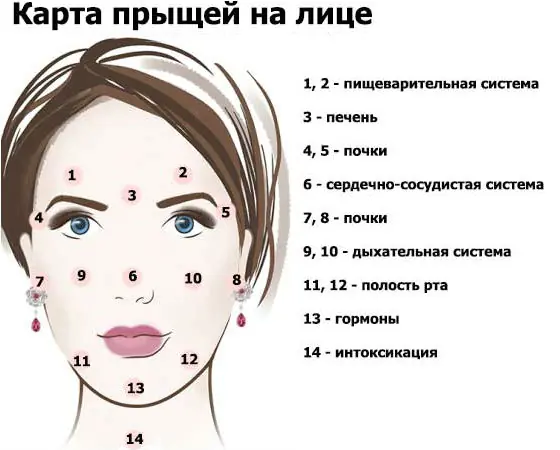
Rashes most often appear on the chin due to gynecological diseases. The cause of acne on the cheeks may be bacterial infection of the lungs, as well as other organs of the respiratory system.
The appearance of rashes on the cheeks due to hormonal imbalance
The cause of hormone imbalance in the body is often physiological changes. For example, a sharp change in hormonal levels is observed in a girl’s body when her ovaries begin to function and puberty occurs. Red pimples, blackheads, and pustules appear on the cheeks and chin of most teenagers, making them worry about their appearance.
The skin deteriorates, as a rule, in women before menstruation. At the same time, single pimples appear on the cheeks. Many pregnant and breastfeeding women suffer from acne or itchy red rashes appearing on their facial skin.
The onset of menopause is another transitional stage associated with the gradual decline of reproductive function and a sharp decrease in the production of sex hormones. During this period, many are bothered by rashes on the cheeks, forehead and around the mouth.
Treatment with hormonal drugs, the use of oral contraceptives, ovarian dysfunction due to inflammation or polycystic disease, as well as diseases of the thyroid gland, pituitary gland and other organs of the endocrine system affect hormonal levels.
Video: Why pimples appear in teenagers. Treatment method
Pimples on the cheeks due to intestinal dysbiosis
When the intestines are disrupted, several factors appear at once that affect the condition of the skin of the cheeks and chin. Among them are metabolic failure, dehydration, vitamin deficiency, accumulation of waste in the intestines and poisoning of the body with toxins, and the death of beneficial microflora.
Red, dense, painful pimples form, and after they disappear, scars or white spots remain.
Eating floury sweet foods is an additional provoking factor for the appearance of rashes on the cheeks. In addition, the condition of the skin of the face with intestinal dysbiosis is adversely affected by the consumption of high-fat whole milk, nuts, strong coffee, and products containing preservatives.
Eating fermented milk products helps restore intestinal microflora. In order for the body to quickly rid itself of toxins, you need to drink as much clean water as possible, and also include foods containing fiber in your diet.
Pimples on the cheeks with demodicosis
If a person notices that the skin of the cheeks has increased oiliness, and many red itchy pimples appear on it, then the presence of demodicosis can be assumed. The mite (Demodex) settles in hair follicles and sebaceous glands. Stimulation of sebum production leads to clogged pores and inflammation of the cheek skin. The irritating effect of mite waste products contributes to the occurrence of itching. Parasites can only be killed with antibacterial agents.
Warning: You should not mask itchy red pimples on your cheeks with cosmetics. For demodicosis, oily creams should not be used. Fats feed ticks, promoting their reproduction.
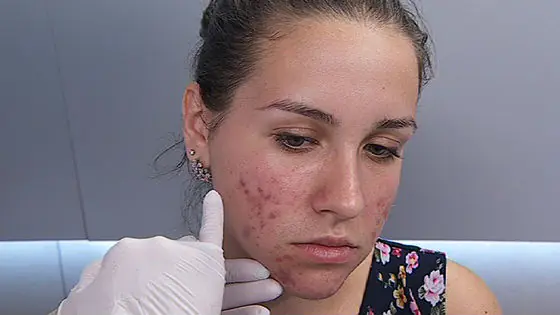
Diagnostic methods
To finally get rid of acne on the cheeks, you need to know the reason for their appearance. Perhaps only special skin care will be enough or special treatment will be required.
Laboratory methods of blood testing are used to diagnose diseases. A general analysis shows the presence of inflammatory diseases. Biochemical analysis is carried out to determine blood sugar levels and liver enzymes. These indicators can be used to judge the state of metabolism.
The presence of intestinal dysbiosis can be determined using a coprogram (stool analysis). The condition of the thyroid gland and ovaries is examined. To do this, a blood test is performed for thyroid hormones, estrogens, progesterone and pituitary hormones.
Mites can be detected by microscopic examination of the contents of the hair follicle from which the pimple formed (analysis for demodicosis). If there are suggestions that the cause of the rash on the cheeks is an allergy, tests are done for various allergens.
The most complete information about the patient’s health status is obtained using ultrasound and other instrumental methods.
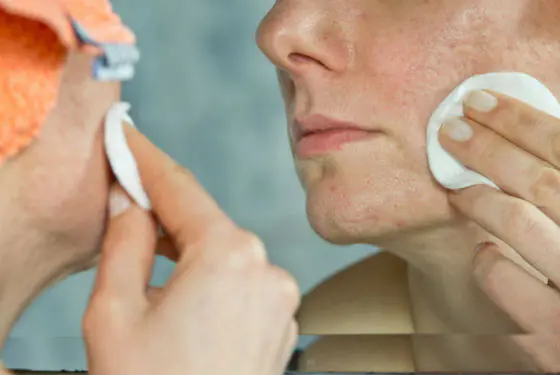
Treatment
If skin rashes appear, you should contact a dermatologist. You may need to consult a gynecologist, endocrinologist, gastroenterologist, or therapist, who will prescribe adequate treatment.
Pharmacy drugs
The choice of treatment tactics depends, first of all, on what caused the appearance of acne on the cheeks and other areas of the face. For intestinal dysbiosis, sorbents that absorb toxins are prescribed, as well as drugs containing lactobacilli (linus, lactofiltrum, probifor).
Correction of hormonal levels is carried out using drugs based on thyroid or ovarian hormones.
Retinoids (preparations containing retinol - vitamin A) are used to suppress the growth of epithelial cells. These include, for example, Differin gel and Retin-A cream.
Antibacterial drugs are used against ticks (sulfur ointment, Metrogyl gel).
Pimples are treated with disinfectant solutions (salicylic acid, alcohol, brilliant green, iodine) and lubricated with anti-inflammatory ointments such as acnestop, skinoren, baziron or drying zinc ointment. Instead of ointment, you can use the pharmaceutical product “water-zinc mash”. Vishnevsky ointment is often used. It draws out the pus and rapid healing occurs.
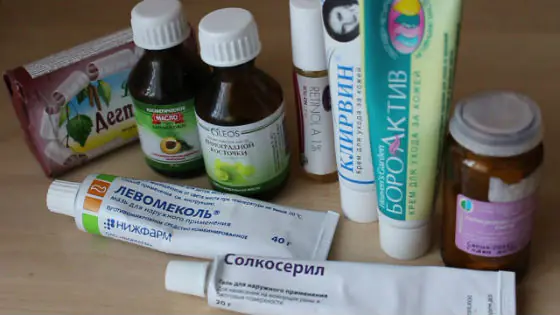
In case of severe inflammation of the facial skin and the formation of a rash, antibiotics are prescribed.
Cosmetologists resort to special procedures that help cleanse the skin and smooth out the unevenness remaining in the place of healed acne. Laser or mechanical resurfacing, microcurrent treatment, and ozone therapy are performed.
Warning: Medicinal ointments and creams can only be used as prescribed by a doctor. Self-medication with products containing sulfur, hormonal substances, and antibiotics can lead to an allergic reaction, skin necrosis and scarring.
Traditional ways to get rid of acne
There are many home remedies for eliminating pimples on the face and other parts of the body. They are designed to clean, disinfect the skin and replenish the lack of nutrients.
Potato mask to relieve skin irritation
With its help you can get rid of small red rashes. Use raw, finely grated potatoes. It is applied to the skin affected by the rash for about 15-20 minutes, after which it is washed and lubricated with moisturizer.
White clay mask with calendula
Compound:
Clay - 3 tbsp. l.
Calendula tincture - 2 tbsp. l.
Lemon juice - 1 tbsp. l.
Application:
Dilute the clay with calendula tincture, add lemon juice, stir. The mixture applied to the skin is washed off after about 15 minutes. Pimples dry out quickly and the skin becomes smooth.
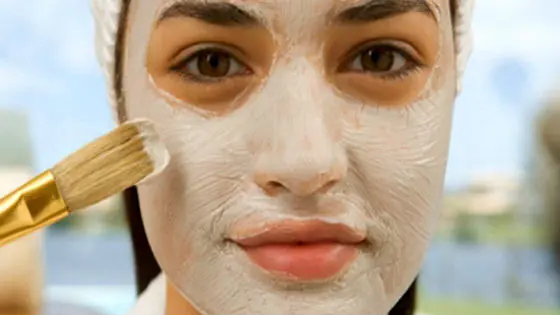
Yeast mask
Fresh yeast is diluted with water to the consistency of thick sour cream, hydrogen peroxide is added to it. Apply to the face every day, gradually increasing the treatment time from 10 minutes to several hours (skin reaction may vary individually).
Astringent agents
Helps tighten pores and reduce oily skin. Decoctions of St. John's wort or oak bark are used (1 tablespoon of dry raw material per 1 glass of water). They are frozen in the freezer, and then wiped with ice cubes on the cheeks several times a day.
Cleansers and anti-inflammatory agents
Decoctions of chamomile, string, sage, and wormwood are used. They will help not only cleanse the pores, but also disinfect the skin and relieve inflammation. After cleaning the skin, pimples are burned with iodine or aloe juice. Apply a compress with Vishnevsky ointment to purulent pimples or apply levomekol ointment to the affected skin. Instead of Vishnevsky ointment, you can use a product made from grated 72% laundry soap and baked onions. You can get rid of scars and spots left on the site of acne by rubbing them with a paste of raw pumpkin or calendula flowers.
Tar soap should be used for washing daily if the skin of the face is heavily covered with acne. This product has a bactericidal and anti-inflammatory effect. With its help you can get rid of demodicosis.
Cosmetologists and doctors emphasize that facial skin must not only be taken care of daily, but also done correctly. It is important to choose products that suit your skin type and do not cause allergies. You should not use questionable cosmetics.
Video: Effective home remedy for acne
Various defects occur on the skin quite often. Causes of acne on cheeks can vary from poor nutrition to serious skin diseases. To determine exactly what causes acne, you should consult a doctor - a specialist will help you accurately determine the cause and choose the most effective treatment method.
Pimples on the cheeks in women
In women, acne is associated with changes in hormonal levels, as well as deterioration of the immune system. Cyclic fluctuations in female hormonal levels create conditions for constant changes in the skin. If any deviations from the norm occur in these fluctuations, the woman experiences various disorders, and acne is far from the most severe among them, but the most noticeable. Especially often, an excess of male hormones in women manifests itself in this way.
Impaired immunity, including local (on the skin), is also associated with the influence of sex hormones - among women immunity is lower, especially in the second phase of the menstrual cycle. For this reason, if a woman does not carefully monitor her health and take care of her skin, acne occurs.
Pimples on cheeks before menstruation
This is one of the types of acne characteristic of women. Acne before menstruation occurs if a woman’s immunity at this moment decreases, which happens with an excess of second-phase hormones or a lack of estrogen. Pimples appear 3-4 days before menstruation, being one of the most reliable signs of impending menstruation.
Some women, accustomed to regular rashes on the face before menstruation, become very worried when they do not notice pimples on time.
The absence of the usual acne rashes can be the first sign of pregnancy for some.
Pimples on the cheeks in men
In men, acne may also appear due to hormonal imbalances, and rashes can indicate either an excess or a lack of sex hormones in the patient. In the same way, an excess of adrenal hormones can manifest itself - Itsenko-Cushing syndrome, which is characterized by redistribution of adipose tissue, changes in complexion, increased sweating and fatigue.
There is also a more common reason for the appearance of defects on the skin of representatives of the stronger sex - insufficient facial care. Many men do not know how to do this or consider cleansing and moisturizing procedures to be an exclusively female prerogative - and do not want to “become effeminate.” This behavior contributes to the appearance of inflammatory foci on the face - and you must agree, acne on the face is not the best sign of masculinity.
Acne on the cheeks of a teenager
This is a very common problem that almost all teenagers face, regardless of gender. The onset of puberty, hormonal changes in the body and changes in immunity have clearly visible external manifestations. Teenage acne can last from several months to 2-3 years. Longer course of acne in a teenager suggests that its causes are more serious than ordinary changes in hormonal levels.
If juvenile acne does not respond to conventional home remedies, you should consult a dermatologist, and possibly an endocrinologist. Only a specialist will find out the true cause of acne on a teenager’s cheeks and prescribe adequate treatment.
Pimple on the cheek of a baby
Small white bumps (miles) are normal in newborns. Their appearance is due to the fact that the newborn’s sebaceous glands do not yet perform their function well enough, so their ducts are often clogged. Also, the amount of acne is influenced by the characteristics of maternal hormones - the baby is born with a high level of maternal hormones in the blood. During the first few days, this level will stabilize, but some unpleasant reactions are possible.
When you see small white heads on a baby's tender cheeks, don't panic. Compliance with basic hygiene standards will help to avoid complications, and pimples will go away on their own - no need to specially squeeze them out, lubricate them with brilliant green or iodine. Tell your pediatrician about the problem - he will help you choose the best treatment.
Diagnosis of the causes of rashes on the cheeks
In order to determine the causes of the rash, a lengthy diagnostic procedure is sometimes required. The patient must undergo a general and biochemical blood test, and, if necessary, blood for hormones. The functions of the gastrointestinal tract and the patient’s dietary habits are also examined in detail.
Food causes of rashes
Unhealthy eating habits are one of the common causes of acne. Facial skin defects appear when food supplies excess amounts of animal fats and insufficient amounts of vitamins A and E. Rashes can also be one of the manifestations of product intolerance (mild forms of allergies). Dealing with “food” rashes is quite easy - you need to adjust your diet so that all the necessary substances enter the body.
Intestinal diseases are the most common cause of rashes in the cheek area
Unlike the previous group, these reasons are more serious and difficult to eliminate. In diseases of the small intestine, which are collectively called malabsorption syndrome, the absorption of nutrients is impaired. This leads to the patient's body lacking important products, despite the fact that they are supplied in sufficient quantities with food.
Colon diseases are accompanied by abundant formation of gases and toxins and their absorption into the blood. This leads to chronic intoxication. Both lead to a deterioration in appearance, in particular to various rashes in the cheek area.
Small red pimples on cheeks
This type of defect most often occurs due to hormonal imbalances, but can also occur in other pathologies - nervous and allergic diseases. The appearance of small red rashes should alert the patient, and if they do not go away on their own within a week, much less new pimples appear, you should consult a doctor.
Treatment of such pathology at home It is quite easy to do - the provoking factor should be identified and eliminated, sometimes you can do this yourself. Usually the trigger for acne is something new - a cosmetic product, a food product. Eliminate it and you can enjoy smooth skin again.
Large subcutaneous internal pimple on the cheek
Internal acne is a type of comedones that occur when the ducts of the sebaceous glands are deeply blocked. In this case, the sebaceous plug is located deep under the skin; a small elevation is visible on the surface, which is not painful when touched, but looks ugly.
The formation of large subcutaneous pimples is associated with disruption of the sebaceous glands, deficiency of essential vitamins, and too thick epidermis. A positive feature is that such comedones rarely become inflamed; if you do not touch them, they go away on their own.
White pimples on cheeks
White pimples are the initial stage of acne. These are formations on the epidermis of a relatively small size, not painful, not itchy. They are mainly an aesthetic problem, especially if there are many of them. They occur mainly due to poor nutrition. With good skin care, they pass quickly; no serious pathologies arise at this stage.
Purulent pimple on the cheek
This is a more serious variant of the disease. It is formed when a bacterial infection joins the blockage of the sebaceous ducts. Active inflammation causes pain, redness of the skin, itching and other symptoms. In addition to an aesthetic defect, such pimples pose a threat to patients with weakened immune systems - they are a constant source of infection.
Such itchy pimples can occur due to hormonal imbalances, skin diseases, and in pregnant women. Another problem is that such purulent pimples often leave pronounced marks in the form of depressions on the skin, red spots, which are then difficult to get rid of.
Why don't pimples on my cheeks go away?
The simplest explanation for why this happens is that the causes of acne have not been eliminated. Until the diagnosis is carried out properly, rashes can appear regularly, recover after each course of treatment and recur. There is only one way to combat this phenomenon - careful diagnosis and elimination of the causes of acne.
The reason for acne that does not go away for a long time on the chin, cheeks and forehead may be:
- Chronic diseases of the digestive tract;
- Chronic hormonal pathologies, taking hormonal medications;
- Diabetes.
Improper facial care also contributes to relapses.
How to get rid of acne on the cheeks: treatment
The approach to treatment must be comprehensive - only in this case is it possible to completely eliminate skin pathologies, cleanse and restore it. Since a combination of several factors most often plays a role, one-sided treatment can only give a temporary effect.
Medications for acne on the cheeks
Drugs for the treatment of acne are quite varied. The most frequently prescribed groups of drugs:
- Intestinal sorbents (activated carbon, smecta);
- Enzyme preparations - both of these groups improve the digestion and absorption of nutrients;
- Vitamin complexes containing retinol and tocopherol;
- Antibiotics – reduce the activity of bacteria on the skin, prescribed for severe cases;
- Antihistamines (anti-allergy) medications to reduce itching.
The selection of the right medicine is carried out by the doctor, this is done individually, often the specialist has to go by trial and error.
Masks for acne on cheeks
Skin care plays an important role in the treatment of acne. Often, an imbalance and the appearance of rashes occur precisely because the face is not sufficiently hydrated, but at the same time it is exposed to a huge number of unfavorable factors.
The advantages of masks are that they give a fairly quick and strong effect. But using them requires time. The following masks are effective in fighting acne:
- Cleansing – eliminate excess sebum, remove “plugs” from clogged sebaceous ducts;
- Moisturizing – maintain normal skin moisture, which reduces the activity of the sebaceous glands;
- Nutritious - necessary for the same purpose;
- Anti-inflammatory – reduce the activity of the inflammatory process;
- Antiseptic – suppress the activity of pathogenic microorganisms.
Masks should be applied to the skin and washed off after a certain time with water without soap. Then a moisturizing or nourishing cream is applied to the face.
Folk remedies for acne on the cheeks
Traditional medicine offers many options for combating acne. In particular, washing with infusions of chamomile, calendula, sage and yarrow can reduce the activity of the inflammatory process and pathogens. Such means are often used in children and teenagers, hoping for their safety. It is important to make sure that the patient is not allergic to the medicinal plant.
Many popular folk recipes are based on the use of alcohol and alcohol tinctures. This is the wrong method of treatment - there is a risk of drying out the skin, causing even greater activity of the sebaceous glands. In this case, recipes that involve the use of oils - sea buckthorn or sunflower - are much more useful. You can add essential oils of eucalyptus, calendula or marigold to them, but in small quantities. To avoid causing chemical burns. Essential oils have the ability to photosensitize* the skin, so they must be applied at least an hour before going outside.
Tips for caring for skin with acne on the cheeks
A few simple care rules that will help reduce the number of acne:
- You need to wash your face twice a day – morning and evening – using special anti-acne products;
- After washing, the skin should be treated with an antiseptic - chlorhexidine or miramistin;
- You can and should use moisturizing and nourishing creams and masks;
- Do not use local antiseptics based on alcohol and hydrogen peroxide;
- Be sure to use cleansing scrubs daily.
These measures are effective in the complex treatment of pathology, since they do not eliminate the cause.
If your skin is acne-prone: Preventing acne on your cheeks
Prevent acne on the cheeks, especially in a man, it is not always possible - chronic diseases, unhealthy habits and the environment do not allow achieving a lasting effect. However, a few important tips:
- Chronic diseases should be identified and treated in a timely manner and the doctor’s recommendations should be followed;
- Add more foods containing vitamins A and E and vegetable oils to your diet;
- Avoid smoking and alcohol;
- If possible, spend time in the fresh air often;
- Wash your face twice a day using cleansers (foams and gels, preferably for problem skin);
- Do not use soap, including liquid soap, for washing;
- In winter, moisturizing and nourishing creams are a must;
- Deep cleansing scrubs should be used every week.
All these measures will help maintain a beautiful appearance.
A pimple on the face is always an unpleasant occurrence, regardless of location. In addition to aesthetic discomfort, rashes indicate the presence of problems inside the body. Acne is most common on the cheeks of women. Their causes vary, and only a doctor can accurately determine them after a full examination.
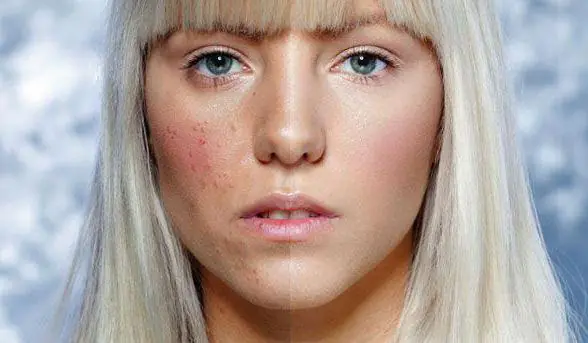
Causes of rashes
Pimples in the cheekbones and cheeks appear when:
- intestinal dysbiosis;
- menstrual irregularities and hormonal imbalances;
- allergic reactions, especially those caused by food;
- disorders of the endocrine system, in particular the thyroid gland;
- lack of microelements and vitamins (especially groups E, B and zinc).
In addition to pathological reasons, pimples can appear in adolescence due to hormonal changes in the body; as a rule, after the body matures, pimples on the cheeks in women disappear. The reasons for their appearance are the excessive activity of the sebaceous glands due to hormonal changes. With diligent skin care and the use of certain cosmetics, problems may also arise, manifested by the appearance of rashes on the cheeks.
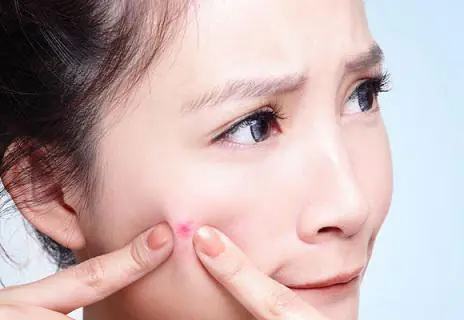
Before the onset of menstruation, due to a hormonal surge, isolated rashes appear on the face, which go away on their own with the onset of menstruation.
Food causes of rashes
Acne on the cheeks in women, the causes of which are poor diet, is much easier to eliminate than in the presence of hormonal disorders. Eating large amounts of processed foods, fatty and fried foods, spicy or salty foods causes problems in the digestive system, which are reflected on the face in the form of rashes.
When the body is heavily polluted, pimples cannot be eliminated with cosmetic procedures and daily care products. Toxins enter the bloodstream from the intestines, spread throughout the bloodstream and appear on the skin in the form of pimples.
They can be localized not only on the face, but also on the body. Most often, rashes appear on the back, shoulders and décolleté. To avoid acne, you need to follow the secrets of health - adhere to proper nutrition and lead an active lifestyle.
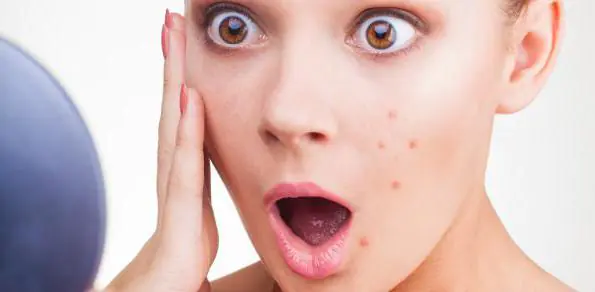
Diagnosis of the causes of rashes on the cheeks
To identify the true cause of pimples on the face, you need to:
- take a blood test - general, biochemical, detailed and be sure to check your blood for sugar;
- do an abdominal ultrasound and gastroscopy to identify gastrointestinal diseases;
- conduct allergy tests to determine the product or substance that causes allergies in a person;
- take a stool test to detect helminthic eggs, dysbacteriosis and Giardia;
- examine the endocrine system and do an ultrasound examination of the thyroid gland;
- women need to be examined by a gynecologist to rule out hormonal imbalances and diseases of the reproductive system.
If all the results are available, the doctor will be able to tell you how to eliminate acne on the cheeks in women; the causes of the rash can also be determined, and then treatment can be prescribed.
Diet and lifestyle
The first thing you need to do is adjust your diet and daily routine. The body must receive the necessary vitamins and microelements that normalize the functioning of all its systems. It is important to get enough rest, spend a lot of time outdoors, lead an active lifestyle and drink enough clean water.
Any bad habits will contribute to the appearance of rashes on the cheeks, so you need to minimize or completely give up alcohol, smoking, fatty and fried foods, salty and spicy foods, sweets and soda.
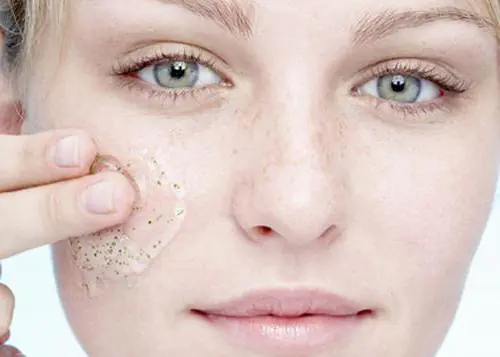
Single pimples are no cause for concern. They only signal that it has become difficult for the body to cope with its work due to overload. If acne covers most of the skin on the body, does not mature and remains subcutaneous, then you need to be examined by a doctor to determine why the pimple appeared on your cheek.
What to do in this case? Pimples cannot be squeezed out on your own; this procedure can lead to the spread of infection to healthy areas of the skin, severe damage to the epidermis and the development of pathological cells.
Acne on the cheeks in women: treatment with medications
Depending on the cause of the rash, the doctor prescribes appropriate medications, the use of gels or ointments. At the initial stage of diseases, doctors prescribe medications that regulate the functioning of the gastrointestinal tract, as well as drugs to strengthen the body’s immune system.
If inflammation on the face is severe, antibacterial therapy is prescribed; it eliminates streptococci, staphylococci and E. coli, which cause intoxication of the body.
For hormonal disorders, it is necessary to take androgenic drugs. It is especially important to carry out hormonal treatment if women have thyroid diseases. At the end of the course of treatment, you need to continue to take supportive measures for the normal functioning of the intestines and immune system.
How to reduce the number of rashes at home
To improve the condition of your skin, you need to take care of it daily and regularly. The most useful procedures are:
- peelings;
- scrubs;
- masks;
- application of antibacterial agents.
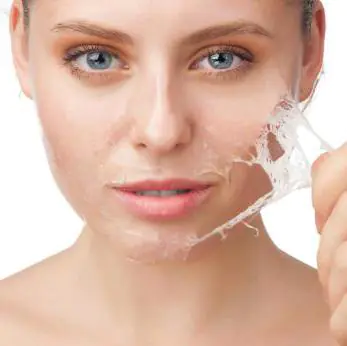
The skin of the cheeks is very delicate and needs special care. Eliminating rashes in this area takes a long time, so you need to prepare a clear care plan and follow it daily, without skipping procedures. In this case, the question will not arise why pimples appeared on the cheeks and how to eliminate them.
Hardware cosmetology for rashes
Hardware cosmetology can help cope with acne on the cheeks. The following procedures will be useful:
- microcurrent treatment;
- laser skin resurfacing;
- ozone therapy;
- mesotherapy;
- dermabrasion.
Regular facial skin care will prevent the appearance of rashes and reduce excessive activity of the sebaceous glands.
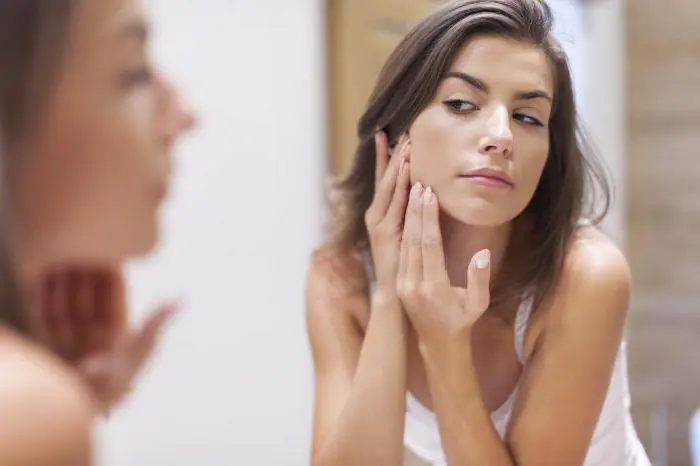
Folk remedies for acne
You can eliminate red pimples on your cheeks with homemade face masks. They can be prepared from any product or purchased ready-made.
A potato mask can improve the condition of even the most irritated skin. It is necessary to peel and grate the potatoes on a fine grater, place on gauze and apply the mask to the face for 15-20 minutes. After this, you need to wash your face with cool water and treat your skin with a moisturizing toner.
Clay masks can be made 2 times a week. The clay is diluted with filtered cool water, lemon juice or essential oils of tea tree, lavender, mint, lemon balm, lemon, fir are added. The clay is applied to the skin in a thin layer; after the mask dries, it must be washed off with warm water and be sure to moisturize the skin of the face and neck.
A mixture of honey and lemon allows you to see the result after just a few uses. But this option is only suitable if you are not allergic to honey.
Preventing facial rashes
Getting rid of rashes is not enough, the main thing is to prevent their reappearance. The main secrets of health will help with this.
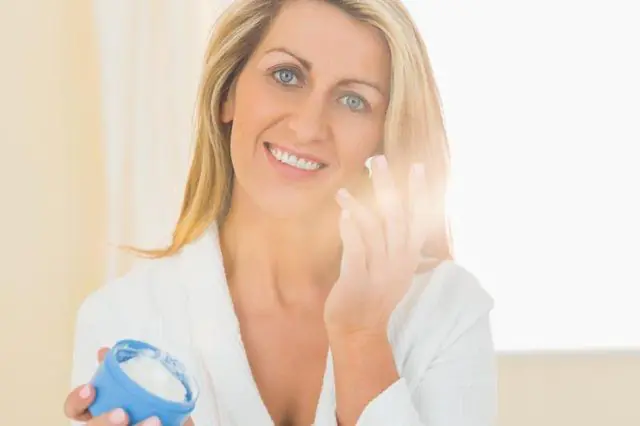
- Every morning and evening you need to carry out hygiene procedures. Cleansers (foam, gel, scrub), toner, milk, and creams should be selected according to your skin type. It is especially important to cleanse your skin of cosmetics in a timely manner.
- You need to adhere to proper nutrition. Eat plenty of fresh fruits and vegetables, dairy products. For healthy skin, you should give up fast food, fatty and fried foods, sweets and carbonated drinks.
- Stressful situations also affect the condition of the skin. Therefore, you need to take care of your nervous system and avoid strong experiences.
- Do not touch your face with dirty hands or squeeze out pimples yourself.
- The cosmetics used must be of high quality and not cause allergic reactions.
- It is necessary to undergo timely examinations to diagnose thyroid diseases in women.
Prevention plays an important role; thanks to early care of the condition of your skin, you will be able to avoid many problems, such as acne, rashes and suppuration. You need to start taking care of your skin as early as adolescence, then excessive activity of the sebaceous glands will not cause major skin problems.



